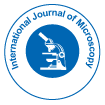Editorial Open Access
Wishing the Journal Good Startup
Ludek Frank*Institute of Scientific Instruments, The Czech Academy of Science, Czech Republic
- *Corresponding Author:
- Ludek Frank
Senior Scientist, Institute of Scientific Instruments
The Czech Academy of Science
Czech Republic
Tel: 605267573
E-mail: ludek@isibrno.cz
Received date: September 21, 2017; Accepted date: September 22, 2017; Published date: September 30, 2017
Citation: Frank L (2017) Wishing the Journal Good Startup. Int J Microsc 1: e101.
Copyright: © 2017 Frank L. This is an open-access article distributed under the terms of the Creative Commons Attribution License, which permits unrestricted use, distribution, and reproduction in any medium, provided the original author and source are credited.
Visit for more related articles at International Journal of Microscopy
Abstract
The new International Journal of Microscopy aims to cover a substantial majority of imaging principles and devices capable of acquiring magnified views of specimens of matter. Techniques employing light, electrons, radiofrequency radiation, atomic probe tips and so on do not have very much in common apart from the production of at least two-dimensional image-like data. Tools for various types of processing and manipulation of these kinds of data sets can certainly be considered applicable to multiple microscopic techniques, but research in the field of such methods and tools is also reported in other journals and a journal of microscopy is not necessarily the first place where readers would seek it. So let us wait for the first piles of manuscripts we receive to see which authors respond to the invitation from the publisher and editors of the International Journal of Microscopy.
The new International Journal of Microscopy aims to cover a substantial majority of imaging principles and devices capable of acquiring magnified views of specimens of matter. Techniques employing light, electrons, radiofrequency radiation, atomic probe tips and so on do not have very much in common apart from the production of at least two-dimensional image-like data. Tools for various types of processing and manipulation of these kinds of data sets can certainly be considered applicable to multiple microscopic techniques, but research in the field of such methods and tools is also reported in other journals and a journal of microscopy is not necessarily the first place where readers would seek it. So let us wait for the first piles of manuscripts we receive to see which authors respond to the invitation from the publisher and editors of the International Journal of Microscopy.
My personal orientation includes scanning microscopy with slow electrons and its instrumentation, methodology and applications. By “slow” electrons I mean electron energies approaching zero, which means electrons impinging on the sample under observation at tens, units or even fractions of electronvolts or even mirrored back without reaching the sample surface itself. More than seven decades have passed since the first publication proposing the introduction of this technique, five decades since the publication of the first scanned electron micrographs acquired at tens of electronvolts (though these were not of any great quality) and about twenty-five years since the publication of high-quality micrographs, but only eleven years have passed since the first commercial SEMs offering this technique were launched by major manufacturers. And it is only quite recently that the community of electron microscopists has begun producing a remarkable number of papers reporting applications of this technique. This all in spite of the fact that the non-scanning version, Low-energy Electron Microscopy (LEEM), has been producing extremely valuable observation data since the 1970s and the fact that it has been possible to purchase this type of microscope since 1995. One of my hopes is, therefore, that our new journal will contribute to acceleration of slow progress for this and allied techniques.
You will not find anything unexpected when reading about the journal’s publication policies and ethics and about the roles of authors, editors, reviewers and the publisher. This is to be a serious journal aiming to establish a good reputation with great care. The “open access” profile requires authors to contribute financially, though it significantly facilitates the dissemination of the published results as well as enhancing the reputation of its authors. Most authors will hopefully accept this situation. Let us wish the International Journal of Microscopy a successful entry to the world of scientific literature.
--Relevant Topics
- Atomic force microscopy
- Auto-fluorescence
- Backscatter electrons
- Confocal microscopy
- Electromagnetic radiation
- Kelvin probe force microscopy
- Magnetic Resonance Microscopy
- Micro-Photogrammetry
- Microscopic technique
- Nonlinear Microscopy
- Optical Coherence Tomography
- Optical microscopy
- Polarising Light Microscopy
- Scanning electron microscope
- Scanning Probe Microscopy
- Transmission electron microscopy
Recommended Journals
Article Tools
Article Usage
- Total views: 2496
- [From(publication date):
September-2017 - Mar 31, 2025] - Breakdown by view type
- HTML page views : 1566
- PDF downloads : 930
